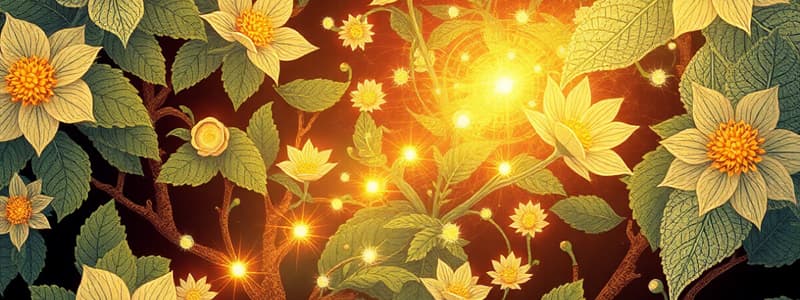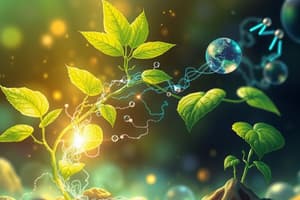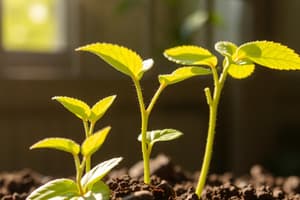Podcast
Questions and Answers
Which of the following is NOT a fundamental mineral ion required by plants?
Which of the following is NOT a fundamental mineral ion required by plants?
- Calcium (correct)
- Potassium
- Nitrogen
- Magnesium
Plants obtain mineral ions passively through diffusion.
Plants obtain mineral ions passively through diffusion.
False (B)
Why are mineral ions essential for plant growth?
Why are mineral ions essential for plant growth?
Mineral ions are essential for plants to synthesize essential biological molecules like proteins, lipids, and nucleic acids. Without these molecules, plants cannot grow or photosynthesize efficiently.
Plants absorb mineral ions from the soil through specialized cells called ______ cells.
Plants absorb mineral ions from the soil through specialized cells called ______ cells.
Match the following mineral ions with their main function in plants:
Match the following mineral ions with their main function in plants:
What is the primary pigment involved in absorbing sunlight for photosynthesis?
What is the primary pigment involved in absorbing sunlight for photosynthesis?
Photosynthesis is an exothermic reaction that releases heat energy.
Photosynthesis is an exothermic reaction that releases heat energy.
What are the two main raw materials used in photosynthesis?
What are the two main raw materials used in photosynthesis?
Plants are classified as ______ because they can produce their own food.
Plants are classified as ______ because they can produce their own food.
Which of the following is NOT a product of photosynthesis?
Which of the following is NOT a product of photosynthesis?
Match the following products of photosynthesis with their primary uses:
Match the following products of photosynthesis with their primary uses:
Explain how plants are considered producers in a food chain.
Explain how plants are considered producers in a food chain.
Plants can use glucose produced by photosynthesis directly for respiration.
Plants can use glucose produced by photosynthesis directly for respiration.
What are the three main factors that limit the rate of photosynthesis?
What are the three main factors that limit the rate of photosynthesis?
Water is considered a limiting factor in photosynthesis because plants need a large amount of water for transpiration.
Water is considered a limiting factor in photosynthesis because plants need a large amount of water for transpiration.
Explain how increasing temperature affects the rate of photosynthesis.
Explain how increasing temperature affects the rate of photosynthesis.
The ______ of an enzyme can change shape when exposed to high temperatures, making it unable to bind to its substrate.
The ______ of an enzyme can change shape when exposed to high temperatures, making it unable to bind to its substrate.
Match the following limiting factors with their descriptions:
Match the following limiting factors with their descriptions:
Which of the following is NOT a limiting factor in photosynthesis?
Which of the following is NOT a limiting factor in photosynthesis?
Increasing the amount of carbon dioxide in the environment always increases the rate of photosynthesis.
Increasing the amount of carbon dioxide in the environment always increases the rate of photosynthesis.
What happens to the rate of photosynthesis when the temperature is below the optimum range for a particular plant species?
What happens to the rate of photosynthesis when the temperature is below the optimum range for a particular plant species?
Which of these enzymes breaks down proteins into smaller polypeptide chains?
Which of these enzymes breaks down proteins into smaller polypeptide chains?
Proteases are enzymes that break down carbohydrates into simple sugars.
Proteases are enzymes that break down carbohydrates into simple sugars.
Where are lipase enzymes produced?
Where are lipase enzymes produced?
Bile is an ______ substance produced in the ______.
Bile is an ______ substance produced in the ______.
Which of the following organs is responsible for the production of bile?
Which of the following organs is responsible for the production of bile?
Mechanical digestion involves breaking down food into smaller pieces without changing the chemical composition of the food molecules.
Mechanical digestion involves breaking down food into smaller pieces without changing the chemical composition of the food molecules.
What is the primary function of villi in the small intestine?
What is the primary function of villi in the small intestine?
The presence of microvilli on the surface of villi further reduces the surface area available for absorption.
The presence of microvilli on the surface of villi further reduces the surface area available for absorption.
What is the name of the process by which small food molecules and ions move from the small intestine into the bloodstream?
What is the name of the process by which small food molecules and ions move from the small intestine into the bloodstream?
The ______ is the process of eliminating undigested food waste from the body.
The ______ is the process of eliminating undigested food waste from the body.
What is the role of blood capillaries in the villi?
What is the role of blood capillaries in the villi?
The movement of ______ helps to move food along and mix it with the enzymes present.
The movement of ______ helps to move food along and mix it with the enzymes present.
Match the following digestive enzymes with their primary function:
Match the following digestive enzymes with their primary function:
What is the main function of the ileum?
What is the main function of the ileum?
Match the following structures with their function in the small intestine:
Match the following structures with their function in the small intestine:
The pancreas secretes digestive enzymes in an acidic fluid, which lowers the pH of the fluid coming from the stomach.
The pancreas secretes digestive enzymes in an acidic fluid, which lowers the pH of the fluid coming from the stomach.
What is the process called that converts amino acids not used for protein synthesis into urea?
What is the process called that converts amino acids not used for protein synthesis into urea?
Proteases are enzymes that break down proteins into ______.
Proteases are enzymes that break down proteins into ______.
Pepsin, a protease, is produced in the small intestine.
Pepsin, a protease, is produced in the small intestine.
What are the two main products of lipid breakdown by lipases?
What are the two main products of lipid breakdown by lipases?
Where is bile stored before being released into the small intestine?
Where is bile stored before being released into the small intestine?
Bile is a basic substance, meaning it has a high pH.
Bile is a basic substance, meaning it has a high pH.
What is the primary role of bile salts in lipid digestion?
What is the primary role of bile salts in lipid digestion?
Which of the following is NOT an accessory organ involved in digestion?
Which of the following is NOT an accessory organ involved in digestion?
Flashcards
Photosynthesis
Photosynthesis
An endothermic reaction where plants convert sunlight into energy, making glucose from CO2 and water.
Chlorophyll
Chlorophyll
A green pigment in chloroplasts that absorbs sunlight for photosynthesis.
Autotrophs
Autotrophs
Organisms that produce their own food from simple molecules using energy from sunlight.
Producers
Producers
Signup and view all the flashcards
Glucose
Glucose
Signup and view all the flashcards
Respiration
Respiration
Signup and view all the flashcards
Starch
Starch
Signup and view all the flashcards
Cellulose
Cellulose
Signup and view all the flashcards
Mineral Ions
Mineral Ions
Signup and view all the flashcards
Nitrogen in Plants
Nitrogen in Plants
Signup and view all the flashcards
Magnesium in Plants
Magnesium in Plants
Signup and view all the flashcards
Function of Mineral Ions
Function of Mineral Ions
Signup and view all the flashcards
Limiting Factors
Limiting Factors
Signup and view all the flashcards
Three Main Limiting Factors
Three Main Limiting Factors
Signup and view all the flashcards
Temperature Effect
Temperature Effect
Signup and view all the flashcards
Kinetic Energy
Kinetic Energy
Signup and view all the flashcards
Successful Collisions
Successful Collisions
Signup and view all the flashcards
Enzyme Denaturation
Enzyme Denaturation
Signup and view all the flashcards
Chloroplasts and Chlorophyll
Chloroplasts and Chlorophyll
Signup and view all the flashcards
Water as a Factor
Water as a Factor
Signup and view all the flashcards
Adaptations of the Small Intestine
Adaptations of the Small Intestine
Signup and view all the flashcards
Villi
Villi
Signup and view all the flashcards
Microvilli
Microvilli
Signup and view all the flashcards
Diffusion Distance in Villi
Diffusion Distance in Villi
Signup and view all the flashcards
Lacteal
Lacteal
Signup and view all the flashcards
Proteases
Proteases
Signup and view all the flashcards
Pepsin
Pepsin
Signup and view all the flashcards
Function of Proteases
Function of Proteases
Signup and view all the flashcards
Lipases
Lipases
Signup and view all the flashcards
Production of Lipases
Production of Lipases
Signup and view all the flashcards
Bile
Bile
Signup and view all the flashcards
Bile Salts
Bile Salts
Signup and view all the flashcards
Pancreas Role in Digestion
Pancreas Role in Digestion
Signup and view all the flashcards
Ileum
Ileum
Signup and view all the flashcards
Large intestine
Large intestine
Signup and view all the flashcards
Pancreas
Pancreas
Signup and view all the flashcards
Liver
Liver
Signup and view all the flashcards
Gall bladder
Gall bladder
Signup and view all the flashcards
Ingestion
Ingestion
Signup and view all the flashcards
Egestion
Egestion
Signup and view all the flashcards
Absorption
Absorption
Signup and view all the flashcards
Study Notes
Photosynthesis
- Photosynthesis is an endothermic reaction, transferring energy from sunlight to chloroplasts in green plants
- Chlorophyll, a green pigment, absorbs sunlight's energy, converting carbon dioxide and water into glucose
- Oxygen is released as a byproduct
- Plants are autotrophs capable of creating their own food
- They are producers, initiating food chains
- Glucose produced is used for energy in respiration, or stored as starch, lipids, cellulose (cell walls), or amino acids
- Raw materials for photosynthesis are carbon dioxide and water
- Light energy is not a substance, therefore not a raw material
Factors Affecting Photosynthesis Rate
- Plants have limited resources, restricting their photosynthetic rate
- Limiting factors include:
- Temperature: Enzymes denature at high temperatures, reducing the reaction rate. At low temperatures, particles have low kinetic energy and collisions are infrequent
- Light intensity: More light increases reaction rate until another factor becomes the limiting one
- Carbon dioxide concentration: The reaction rate increases proportionally with carbon dioxide until another factor becomes the limiting one
- Chlorophyll and the number of chloroplasts also impact the rate, affected by diseases, nutrient deficiency, or genetic traits
Practical Investigating Photosynthesis
- Demonstrates oxygen production by plants submerged in water (e.g., pondweed)
- Oxygen is produced as bubbles
- Apparatus: beaker, pondweed, funnel, boiling tube, splint
- Method:
- Submerge pondweed in a beaker of water
- Invert a funnel over the pondweed
- Place a boiling tube over the end of the funnel
- Observe bubbles and test with a glowing splint (to identify oxygen)
- This can test rates of photosynthesis over time
Leaf Structure and Adaptations
- Leaves have specialized structures for optimal photosynthesis:
- Wax cuticle: Protects against water loss
- Upper epidermis: Thin, transparent for light penetration
- Palisade mesophyll: Tightly packed chloroplasts for maximum light absorption
- Spongy mesophyll: Has air spaces to maximize diffusion of gases (carbon dioxide and oxygen)
- Lower epidermis: Contains stomata for gas exchange
- Stomata: Open to allow carbon dioxide in, close to prevent water loss
- Guard cells: Regulate stomata opening and closing
- Vascular bundle: (xylem and phloem): Transports water, minerals, and sugars
- These structures are optimized for absorbing light, carrying out photosynthesis, and minimizing water loss
Plants and Mineral Ions
- Plants need various mineral ions for growth and health, beyond carbohydrates
- Two essential ions:
- Magnesium: Needed to make chlorophyll
- Nitrogen: Needed to make amino acids (proteins)
- Deficiencies in these ions result in visible symptoms (e.g., yellowing, stunted growth)
Balanced Diet
- A balanced diet contains the necessary proportions of food groups for good health:
- Carbohydrates (energy)
- Proteins (growth and repair)
- Lipids (energy storage, insulation)
- Fibre (intestinal health)
- Vitamins and minerals (various functions)
- Water (essential for bodily functions)
- Imbalances in these ratios leads to malnutrition, potentially causing various health issues such as starvation, coronary heart disease, constipation, and obesity
Role of Digestive Enzymes
- Digestive enzymes break down large, insoluble molecules into smaller, soluble molecules for absorption and assimilation
- Carbohydrases: Amylase (breaks down starch into maltose), Maltase (breaks maltose into glucose)
- Proteases: Pepsin (breaks proteins into polypeptide chains) and other proteases (break polypeptide chains into amino acids)
- Lipases: break down lipids into glycerol and fatty acids
Bile
- An alkaline substance produced by the liver
- Stored in the gall bladder
- It:
- Neutralizes stomach acid
- Emulsifies fats (increases surface area for lipase action)
Small Intestine: Structure and Adaptations
- The small intestine is the primary site for nutrient absorption.
- Features increasing absorptive capacity include:
- Large surface area: Folds, villi, microvilli
- Thin walls: Short diffusion distance
- Good blood supply (capillaries): Rapid transport of absorbed nutrients
- Lacteals (lymph vessels): Carry absorbed fats (lipids)
Studying That Suits You
Use AI to generate personalized quizzes and flashcards to suit your learning preferences.




